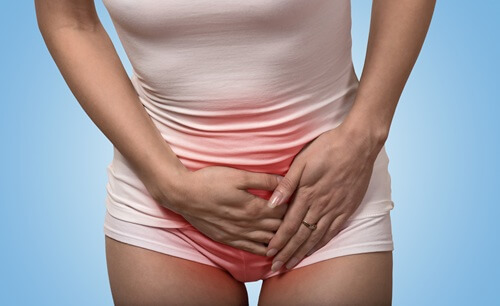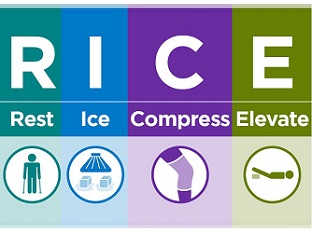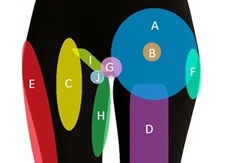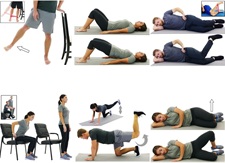- Home
- Hip Pain Diagnosis
- Osteitis Pubis
Osteitis Pubis
Written By: Chloe Wilson, BSc(Hons) Physiotherapy
Reviewed by: KPE Medical Review Board

Osteitis pubis is a painful condition that affects the front of the pelvis.
It develops where the left and right pubic bones meet at the pubic symphysis joint.
Osteitis pubis is a common cause of groin pain in athletes and active individuals, especially those involved in kicking sports or activities with lots of twisting and turning. It is also common during and after pregnancy.
With the right treatment, most cases will settle down within a few weeks or months.
In this article, we’ll look at what osteitis pubis is, what causes it, the key symptoms to look out for, how it is treated, and how long it usually takes to recover.
What Is Osteitis Pubis?

Osteitis pubis is an overuse injury that causes inflammation of the pubic symphysis, the cartilage joint that connects the two halves of the pelvis at the front.
It also affects the surrounding soft tissues, including ligaments and the tendinous attachments of the lower abdominal and hip adductor muscles.
Th symphysis pubis joint is designed to provide a small amount of movement for flexibility and shock absorption, especially during walking or running. However, when the area is subjected to excessive or repetitive stress, such as from running, jumping, or rapid directional changes, it can become inflamed and painful.
Osteitis pubis can range from a mild irritation to a chronic inflammatory problem that limits both athletic performance and daily movement. In advanced cases, it may even cause degeneration of the joint or result in bony changes visible on imaging.
Osteitis pubis is most common in:
- Athletes: especially footballers, runners, hockey and basketball players
- Pregnant Women: or those who have recently given birth
- Post-operative Patients: particularly after pelvic or urological surgery
Osteitis pubis is a fairly rare condition and accounts for less than 15% of case or groin or inner thigh pain. But if left untreated, it can become a chronic and frustrating issue.
Osteitis Pubis Causes
There are several reasons why someone might develop osteitis pubis and common causes include:
- Repetitive stress from activities involving lots of running, kicking, pivoting or twisting motions
- Muscle imbalances around the pelvis, especially weak or tight abdominal and groin muscles
- Pelvic instability or excessive motion at the pubic symphysis
- Post-surgical changes, particularly after procedures like prostate surgery or bladder operations
- Pregnancy and childbirth, which can place strain on the pelvic girdle due to hormonal laxity and weight changes
- Sudden increases in training intensity or volume, especially in sports involving kicking or cutting motions
- Poor biomechanics, such as excessive pelvic tilt, leg length discrepancies, or altered gait patterns
In athletes, osteitis pubis often develops gradually due to repeated micro trauma rather than a single injury. Improper warm-up, inadequate recovery, and muscle imbalances can all increase the risk.
Osteitis Pubis Symptoms
Symptoms of osteitis pubis usually develop slowly over time and may fluctuate in intensity. Common signs and symptoms include:
- Pain at the front of the pelvis that may radiate to the groin, inner thigh or lower abdomen. People usually describe it as a dull, aching pain
- Tenderness and swelling over the pubic bone, particularly at the pubic symphysis
- Increased pain with movement, especially walking, running, kicking, turning, or pushing off
- Morning stiffness or aching after periods of inactivity
- Increased pain with activities that stress the pelvis, such as getting out of bed, sit-ups, coughing, sneezing, climbing stairs or standing on one leg
- Weakness in the hip or groin muscles, especially during resisted movement
- Clicking or popping sensations may occur with movement
Osteitis Pubis Diagnosis
Diagnosing osteitis pubis requires a detailed assessment from a healthcare provider, typically a physical therapist, sports medicine doctor, or orthopaedic specialist. The diagnosis is based on a combination of physical examination, medical history, and imaging studies.
At the clinical examination, your clinician will:
- Take A Thorough History: including asking about your activity levels, recent injuries, training habits, and any surgeries or pregnancies
- Palpate The Area: pressing over the pubic symphysis usually reproduces the pain. There may be localised tenderness and swelling
- Test Hip Strength And Flexibility: particularly the adductors, hip flexors, glutes and abdominals
- Perform Functional Tests: such as resisted leg raises, single-leg stance, sit-up tasks or hop tests to see if they reproduce symptoms which would indicate osteitis pubis
- Assess Gait And Posture: to identify movement abnormalities or asymmetries
Imaging studies may be used to confirm the diagnosis or rule out other possible conditions:

- X-rays: can show joint space irregularities, bony erosion or sclerosis at the pubic symphysis
- MRI: is more sensitive and can detect early inflammatory changes, soft tissue involvement, and bone marrow edema
- Ultrasound: helpful for assessing soft tissue inflammation and guiding injections
- Bone Scans: occasionally used to detect active inflammation in more subtle or persistent cases
Differential Diagnosis
Several conditions can mimic osteitis pubis causing inner thigh pain such as:
- Groin strain or adductor tendinopathy
- Symphysis Pubis Dysfunction (common in pregnancy)
- Inguinal or femoral hernia
- Hip labral tear
- Femoroacetabular Impingement (FAI)
- Urinary or gynaecological issues
- Osteomyelitis (infection of the pubic bone)
A thorough clinical exam and the right imaging studies help distinguish between these conditions and ensure appropriate treatment.
#CommissionsEarned from Amazon on qualifying purchases
Osteitis Pubis Treatment
Most cases of osteitis pubis respond well to non-surgical treatment. The goals of treatment are to reduce inflammation, relieve pain, restore muscle balance, and gradually return to activity. Osteitis pubis treatment usually involves a combination of:
1. Rest and Activity Modification
The best place to start with osteitis pubis treatment is to avoid aggravating activities such as sprinting, kicking, or heavy lifting. This helps reduce irritation and gives the tissues time to heal.
Athletes often require a temporary break (up to 6 months) from sport to allow the inflammation to settle. Cross-training with low-impact activities like swimming or cycling may be allowed.
2. Ice and Pain Relief
Applying ice packs to the front of the pelvis for 15–20 minutes a few times a day can help reduce pain and inflammation at the symphysis pubis.
Over-the-counter anti-inflammatories like ibuprofen may also be helpful in the early stages.
3. Physical Therapy
Physical therapy is a really important part of osteitis pubis treatment and may involve a combination of:
- Core strengthening to support the pelvis and reduce strain on the pubic symphysis. Pilates can be really helpful for this
- Hip strengthening exercises, focusing on the adductors, glutes, and abdominals
- Stretching exercises for tight muscle groups e.g. hip flexors, hamstrings
- Pelvic stability training to improve control and reduce strain on the pubic symphysis
- Manual therapy to address any joint or soft tissue restrictions and improve pelvic alignment
4. Taping or Support Belts

In some cases, taping techniques or pelvic support belts can help reduce movement and discomfort around the pubic symphysis during activity.
Pelvic support belts are particularly helpful during pregnancy and some have an extra strap that goes around the top of the bump. They can really help to improve pelvic stability and make walking more comfortable.
5. Injections
If symptoms are severe or persistent, corticosteroid injections may be considered to help reduce inflammation. These should be used alongside, not instead of, physiotherapy.
6. Surgery
Surgical intervention for osteitis pubis is rare (5-10% of cases) and typically reserved for cases that fail to respond to at least 6–12 months of conservative treatment. Surgical options may include:
- Pubic Symphysis Curettage: where inflamed tissue is removed from the joint
- Symphysiodesis: a fusion of the pubic symphysis to stabilise the joint
- Wedge Resection: where part of the symphysis pubis bone is removed
Osteitis pubis surgery is generally considered a last resort due to the long recovery time and potential risks, but it can provide relief for chronic, debilitating cases.
Osteitis Pubis Recovery Time
Recovery time from osteitis pubis varies depending on the severity and duration of symptoms, how early treatment begins, and individual factors like fitness level and rehab compliance.
Typical recovery times for osteitis pubis are:
- Mild Cases: 4–6 weeks with early intervention
- Moderate Cases: 2–4 months
- Severe or Chronic Cases: 6–12 months
It is really important to follow a gradual return-to-play plan and not rush back into full activity too soon, as this can lead to recurrence of the condition. With the right treatment and rehab plan, most people fully recover and return to their previous level of function.
Osteitis Pubis Prevention
While not all cases can be avoided, there are several steps you can take to reduce your risk of developing osteitis pubis:
- Warm up properly before exercise, especially before high-intensity or change-of-direction sports
- Gradually increase training loads to avoid sudden spikes in activity
- Incorporate regular strength training, particularly for the core, glutes, and groin muscles
- Address muscle imbalances with targeted stretching and strengthening exercises
- Avoid overtraining and schedule adequate rest and recovery days
- Improve movement mechanics with the help of a physical therapist or coach, especially if you have a history of pelvic or groin issues
- Wear appropriate footwear and consider orthotics if you have foot or gait abnormalities
- Address any underlying biomechanical issues, such as leg length discrepancies or pelvic tilt
Oseitis Pubis Summary
Osteitis pubis is a painful inflammatory condition of the pubic symphysis at the front of the pelvis, often triggered by repetitive stress or biomechanical overload. It commonly affects athletes and pregnant or postpartum women, and it can significantly impact movement and performance.
Osteitis pubis typically presents as groin and inner thigh pain, tenderness, and stiffness around the front of the pelvis.
Early diagnosis, rest, targeted physical therapy, appropriate activity modification and gradual return to activity are key to recovery. While it can be a slow-healing condition, most people make a full recovery from osteitis pubis with time and proper care.
If you're struggling with persistent groin or pelvic pain, don't ignore it — early intervention can make all the difference in getting you back to doing what you love.
You may also be interested in the following articles:
- Front Hip Pain
- Outer Hip Pain
- Upper Thigh Pain
- Groin Muscle Strain
- Snapping Hip Syndrome
- Knee Pain Diagnosis Chart
- Glute Strengthening Exercises
Related Articles
RICE Treatment
February 1, 2024
Hip Pain Diagnosis
September 16, 2025
Hip Strengthening
September 24, 2025
Medical & Scientific References
- Osteitis Pubis. National Library Of Medicine
- Management Of Osteitis Pubis In Athletes: Rehabilitation And Return To Training – A Review Of The Most Recent Literature. Open Access Journal Of Sports Medicine
- Osteitis Pubis. Radiopaedia
Last Updated: September 18th, 2025
Next Review Due: September 18th, 2027





